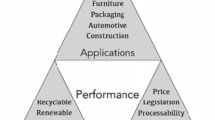Abstract
Natural fibre composite based on polylactic acid (PLA) composite is of special interest because it is entirely from renewable resources and biodegradable. Some samples of jute/PLA composite and PLA alone made 6 years ago and kept in tropical climate on a shelf shows too fast ageing degradation. In this work, an accelerated ageing method for natural fibres/PLA composite is proposed and tested. Experiment was carried out with jute and flax fibre/PLA composite. The method was compared with the standard ISO 1037-06a. The residual flexural strength after ageing test was compared with the one of common wood-based panels and of real aged samples prepared 6 years ago.









Similar content being viewed by others
References
S. Pilla, Handbook of Bioplastics and Biocomposites Engineering Applications (USM, Johor Bahru, 2011), pp. 1–3
S.V. Joshia, L.T. Drzalb, A.K. Mohanty, S. Arorac, Are natural fiber composites environmentally superior to glass fiber reinforced composites? Compos. Part A 35, 371–376 (2003)
H.J. Porck, Rate of Paper Degradation: The Predictive Value of Artificial Aging Tests (European Commission on Preservation and Access, Amsterdam, 2000)
India Meteorological Department (2014), Ever recorded maximum and minimum temperatures up to 2010. Retrieved May 2014
C. Zandvliet, N.R. Bandyopadhyay, D. Ray, Water absorption of jute/polylactic acid composite intended for an interior application and comparison with wood-based panels. J. Inst. Eng. (India): Series D. 95(1), 49–55 (2014)
S. Karlsson, B.S. Ndazi, Characterization of hydrolytic degradation of polylactic acid/rice hulls composites in water at different temperatures, Department of Fibre and Polymer Technology, Royal Institute of Technology (KTH), Stockholm, Sweden. Res. J. Recent Sci. 1(9), 54–58 (2012)
T. Yu, J. Ren, S. Li, H. Yuan, Y. Li, Effect of fibre surface-treatments on the properties of poly(lactic acid)/ramie composites. Compos. Part A 41, 499–505 (2010)
S. Dixit, P. Verma, The effect of surface modification on the water absorption behavior of coir fibers, Department of Chemistry, MANIT, Bhopal, Pelagia Research Library. Adv. Appl. Sci. Res. 3(3), 1463–1465 (2012)
S. Pavan Ku, Effect of alkali treatment on jute fibre composites, National Institute of Technology, Rourkela, India, thesis, 2007
Y. Rudeekit et al., Determining biodegradability of polylactic acid under different environments. J. Metals Mater. Miner. 18(2), 83–87 (2008)
L.Siparsky Georgette, J. Kent, F. Voorhees, Article dimensions, crystallinity, and blends will affect the rate of degradation. J. Environ. Polym. Degrad. 6(1), 761–768 (1998)
K.-L.G. Ho, A.L. Pometto III, P.N. Hinz, Effects of temperature and relative humidity on polylactic acid plastic degradation. J. Environ. Polym. Degrad. 7, 83–92 (1999)
M. Rejaul Kaiser, Mechanical, morphological and thermal properties of hybrid kenaf fibre/nanoclay reinforced polylactic acid composite, thesis for Master of science of Kulliyyah of Engineering University, 2012
T. Strang, D. Grattan, Temperature and humidity considerations for the preservation of organic collections. E Preserv. Sci. 6, 122–128 (2009)
ASTM Standard D1037, Standard test methods for evaluating properties of wood-base fibre and particle panel materials (American Society of Testing and Materials, Philadelphia, 1994)
J.A. Youngquist, Wood-based panels, their properties and uses—a review. in Proceedings, Technical consultation on wood-based panel. Expert consultation, Food and Agriculture Organization of the United Nations, Rome, Italy, September 28–October 1 1987, pp. 116–124
J.D. Mcnatt, C.L. Forest, Analysis of ASTM D 1037 accelerated-aging test products research society. For. Prod. J. 39(10), 51–57 (1989)
A. Okkonen, B.H. River, Outdoor aging of wood-based panels and correlation with laboratory aging: part 2, forest products research society. For. Prod. J. 46(3), 68–74 (1996)
Acknowledgments
The authors thankfully acknowledge the support of the Institution of Engineers (India) for carrying out Research & Development work in this area.
Author information
Authors and Affiliations
Corresponding author
Rights and permissions
About this article
Cite this article
Zandvliet, C., Bandyopadhyay, N.R. & Ray, D. Proposition of an Accelerated Ageing Method for Natural Fibre/Polylactic Acid Composite. J. Inst. Eng. India Ser. D 96, 151–158 (2015). https://doi.org/10.1007/s40033-015-0070-z
Received:
Accepted:
Published:
Issue Date:
DOI: https://doi.org/10.1007/s40033-015-0070-z




